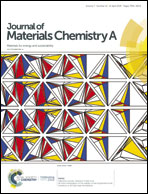Stringing MOF-derived nanocages: a strategy for the enhanced oxygen evolution reaction†
Abstract
Metal–organic frameworks (MOFs)-derived materials have recently emerged as promising electrocatalysts for oxygen evolution reactions (OER), and integrating multi-active sites into the MOF-derivatives still remains a significant challenge in the renewable energy area. Thus to greatly improve the functions of the materials, herein, we developed an effective strategy to construct the lattice strain and high-energy interfaces by fabricating bunched MOF-derived CeOx/CoS along long CeO2 nanorods (L-CeO2NRs), which can be used as efficient OER electrocatalysts. Our design principle involves the formation of lattice strain between the units through the epitaxial compression growth of MOF-derived hollow CoS nanocages along CeO2 NRs and the further generation of high-energy interfaces through interactions between each two CeOx/CoS polyhedrons with highly active heterostructure, lattice defects and grain boundaries. This study afforded a novel approach to tune the lattice strain and interface-catalysis engineering, thus unlocking the hidden potential of MOF-derived materials for effective catalytic applications.



 Please wait while we load your content...
Please wait while we load your content...